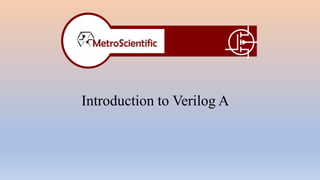Verilog-A.pptx
- 2. Verilog AMS Verilog A Hardware Description Language
- 3. Verilog A vs SPICE Verilog-A designed to describe models for SPICE-class simulators SPICE simulators work by building up a system of nonlinear differential equations that describe the circuit that they are to simulate SPICE representation of a circuit being much slower to simulate than a Verilog representation.
- 4. Verilog vs Verilog-A Module A unit of Verilog code that is used to describe a component. A circuit is described with a hierarchical composition of modules In Verilog, built-in primitives generally describe gates In Verilog-A, the built-in primitives describe common circuit components Resistors Capacitors Inductors Semiconductor Devices
- 5. Structural Model A module that simply refers to other modules is often referred to as a structural model, or a netlist Behavioral model. a module that uses equations to describe a component is referred to as a behavioral model. In Verilog-A, components are constructed using nodes and branches. Modeling in Verilog-A
- 6. Modeling in Verilog-A (Cont.) Description consists of two things: The way that the nodes and branches connected (their topology), The way in which the potential and flow are related on each branch (the branch relations).
- 7. Modeling in Verilog-A (Cont.) module resistor (t1, t2); electrical t1, t2; parameter real r=1; branch (t1, t2) res; analog V(res) <+ r*I(res); endmodule module resistor (t1, t2); electrical t1, t2; parameter real r=1; analog V(t1,t2) <+ r*I(t1,t2); endmodule
- 8. module vdd (dd); electrical dd; parameter real dc=2.5; analog V(dd) <+ dc; endmodule Modeling in Verilog-A (Cont.)
- 9. Modeling in Verilog-A (Cont.) module series_rlc (t1, t2); electrical t1, t2; parameter real r=1; parameter real l=1; parameter real c=1 exclude 0; analog begin V(t1,t2) <+ r*I(t1,t2); V(t1,t2) <+ l*ddt(I(t1,t2)); V(t1,t2) <+ idt(I(t1,t2))/c; end endmodule
- 10. Modeling in Verilog-A (Cont.) module shunt_rlc (t1, t2); electrical t1, t2; parameter real r=1 exclude 0; parameter real l=1 exclude 0; parameter real c=1; analog begin I(t1,t2) <+ V(t1,t2)/r; I(t1,t2) <+ idt(V(t1,t2))/l; I(t1,t2) <+ c*ddt(V(t1,t2)); end endmodule
- 11. Modeling in Verilog-A (Cont.) module shunt_rlc (t1, t2); electrical t1, t2; parameter real r=1; parameter real l=1; parameter real c=1; branch (t1, t2) res, ind, cap; analog begin V(res) <+ r*I(res); V(ind) <+ l*ddt(I(ind)); I(cap) <+ c*ddt(V(cap)); end endmodule
- 12. Modeling in Verilog-A (Cont.) module series_rlc (t1, t2); electrical t1, t2, n1, n2; parameter real r=1; parameter real l=1; parameter real c=1; branch (t1, n1) res; branch (n1, n2) ind; branch (n2, t2) cap; analog begin V(res) <+ r*I(res); V(ind) <+ l*ddt(I(ind)); I(cap) <+ c*ddt(V(cap)); end endmodule
- 13. Modeling in Verilog-A (Cont.) // voltage controlled voltage source module vcvs (pout, nout, pin, nin); electrical pout, nout, pin, nin; parameter real gain=1; analog V(pout,nout) <+ gain*V(pin,nin); endmodule
- 14. Modeling in Verilog-A (Cont.) // voltage controlled current source module vccs (pout, nout, pin, nin); electrical pout, nout, pin, nin; parameter real gain=1; analog V(pout,nout) <+ gain*I(pin,nin); endmodule
- 15. Modeling in Verilog-A (Cont.) // current controlled voltage source module ccvs (pout, nout, pin, nin); electrical pout, nout, pin, nin; parameter real gain=1; analog I(pout,nout) <+ gain*V(pin,nin); endmodule
- 16. Modeling in Verilog-A (Cont.) // current controlled current source module cccs (pout, nout, pin, nin); electrical pout, nout, pin, nin; parameter real gain=1; analog I(pout,nout) <+ gain*I(pin,nin); endmodule
- 17. Thank You
















